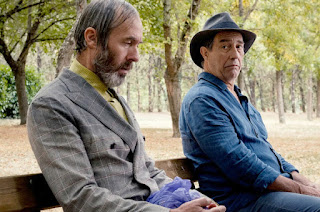Directed by John-Paul Davidson and Stephen Warbeck; produced by Daniel-Konrad Cooper and Dominic Dromgoole
A man (Ciarán Hinds) spends all day at a table outside a Marseilles restaurant, a vaguely dissatisfied expression on his face. In the evening, he sees five men throw what looks to be a shrouded body into a canal. When they spot him, the man hurries back to his hotel and departs on what seems to have been a planned journey north across France.
This is a movie that defies the genres. It has been described as a comedy – the poster, with its misleading ‘tagline’, implies it, too – and, while it has amusing moments, mostly silent, it is not really a comedy. Nor is it a drama. I would describe the atmosphere in the film as one of gentle melancholy, a happy kind of sad, if you will, or perhaps close to what Germans call Sehnsucht.
As for its form, that too is difficult to place. Though superficially a straightforward, if episodic, adventure, The Man in the Hat has no plot, no story-line, at least on the surface. It is a series of vignettes, some of which feature the Man at their centre; in others, he merely observes or eavesdrops on a scene, or on dialogue.
The movie is, possibly, random memories, woven together into a very loose narrative, or it may be a dream. There are elements of the surreal to it: the Man keeps seeing or meeting the same people, though, logically, he should not, and he does not think this strange. It could be an allegory; for what also remains a puzzle, though clues may be taken from the phrase the Man chalks on the trunk of a tree, and from the fact that most of the vignettes appear to be about loss.
Hinds is the main performer, but his character, about which we learn nothing directly, is, as I wrote above, not always in the middle of events. Hinds is called on to react a great deal, such as when he first meets a couple of moonshiners who wordlessly agree to help him with automobile troubles, or when he overhears an involved story featuring a girl’s vanished boyfriend. While there is some mugging for the camera, by him and other actors, in the style favoured by silent-film makers, he nonetheless, with just a couple of words spoken through the film (other players say much more), make us sympathise with the Man.
Others in the cast do very well. They are a mixture of British and French performers, few, perhaps, known to North American audiences except Stephen Dillane. Aoife Hinds, the star’s daughter, plays a singing garage mechanic, while her mother, Hélène Patarot, portrays another.
The writing is very good; at least I think it is: for what I perceive the movie to be about, it is very good. There are moments of misfire. One example is when the Man spills olive oil on his shirt. He cuts out the stained patch of cloth, then uses a felt marker to make a portion of his white under-shirt the same colour as his outer garment, creating the illusion of a complete shirt. This Mr Bean-like scene is incongruous, since nothing else the Man does is similar. The writers were probably waiting years to include it in some film or other.
Yet there are effecting scenes, such as when the Man consoles another, who is crushed by grief, or when a wistful song plays while the Man sits seemingly alone in his car.
This is certainly not a movie for all tastes. It may be seen as a waste of time by many; one amateur reviewer called it a ‘failed travelogue’; others saw no point to it, or missed what I think was the point and considered it no more than light-hearted fun. Professional reviewers seem to have applied the word ‘whimsical’ to it quite often. I would not call much in The Man in the Hat whimsical. Nor is it depressing. Writing this review a week after I watched the movie, I find that I like it more now than I did immediately after its conclusion, and think about it more than I did. If you like that sort of motion picture, you will find The Man in the Hat worth its ninety-five minutes.









Well, the movie certainly sounds different, and I like "different." I'll have to check this out.
ReplyDeleteI'll be interested in your interpretation if you watch it.
Delete